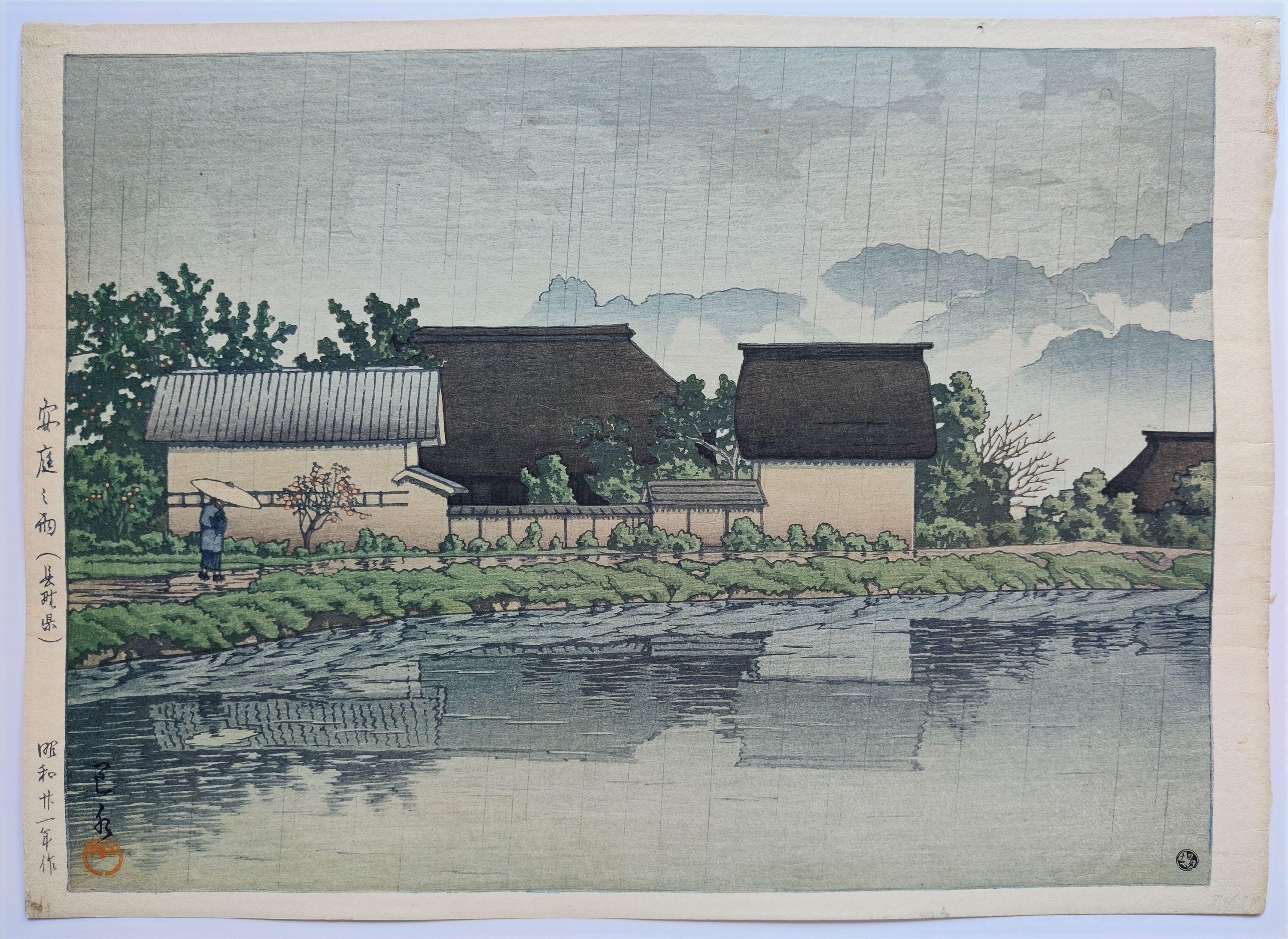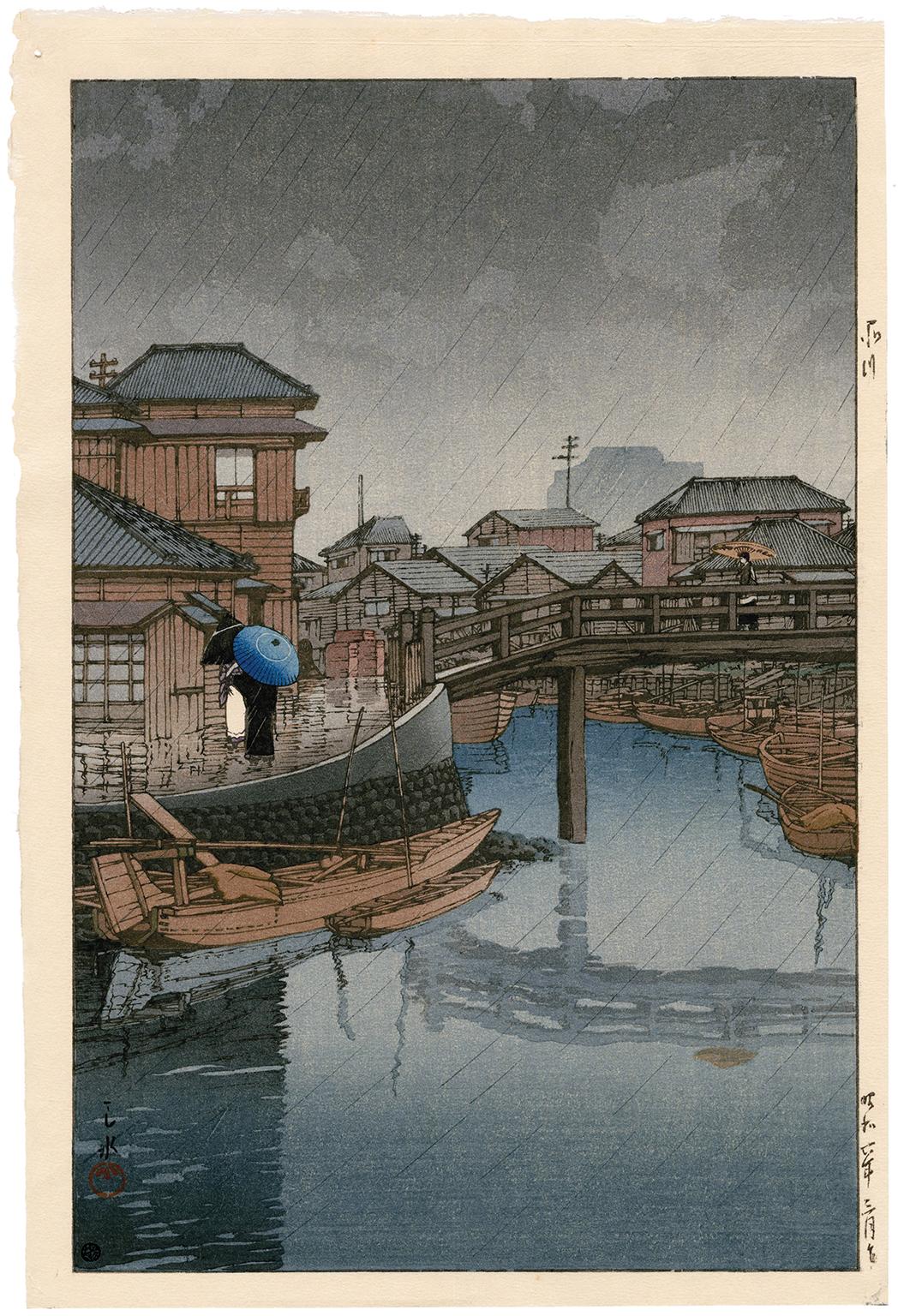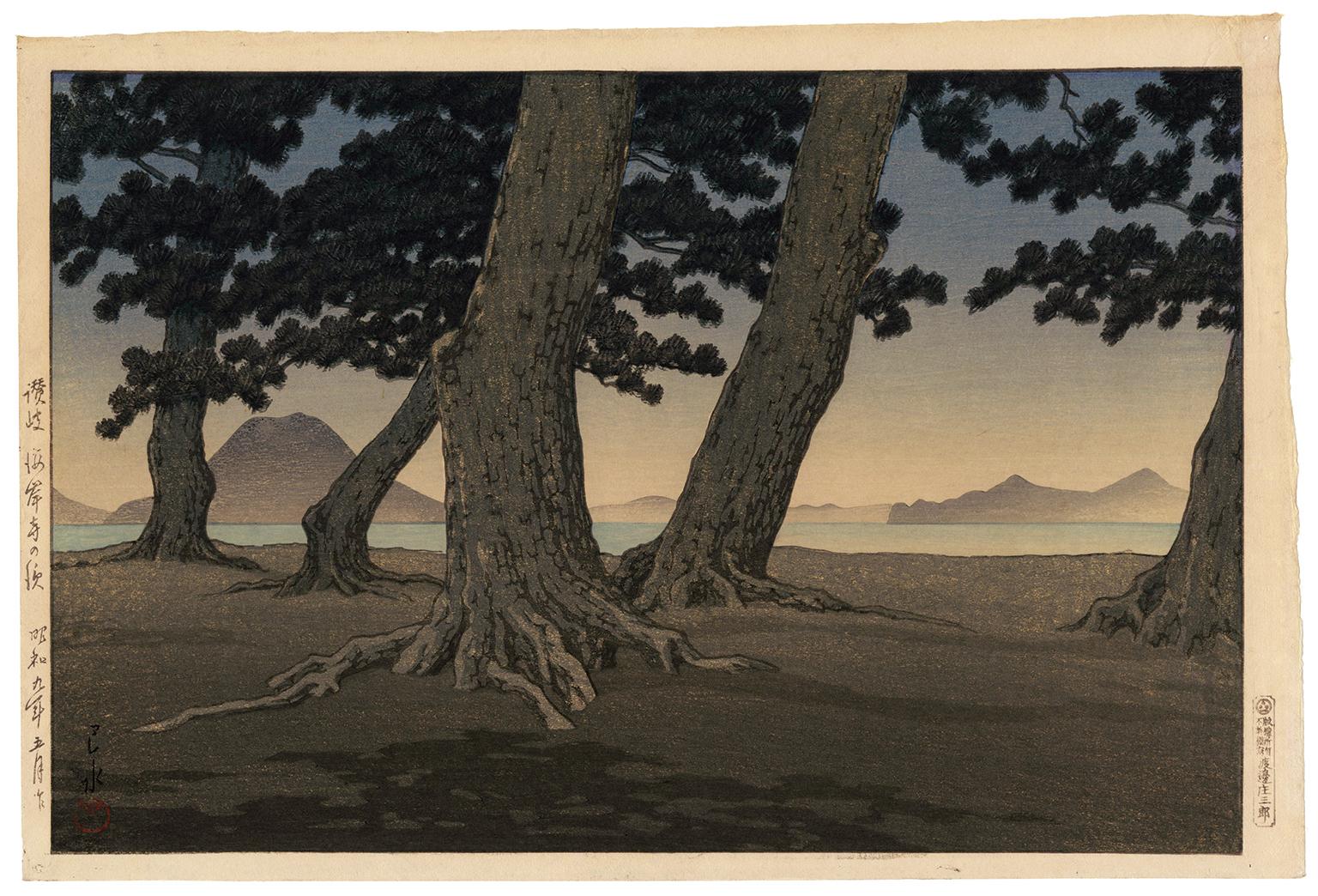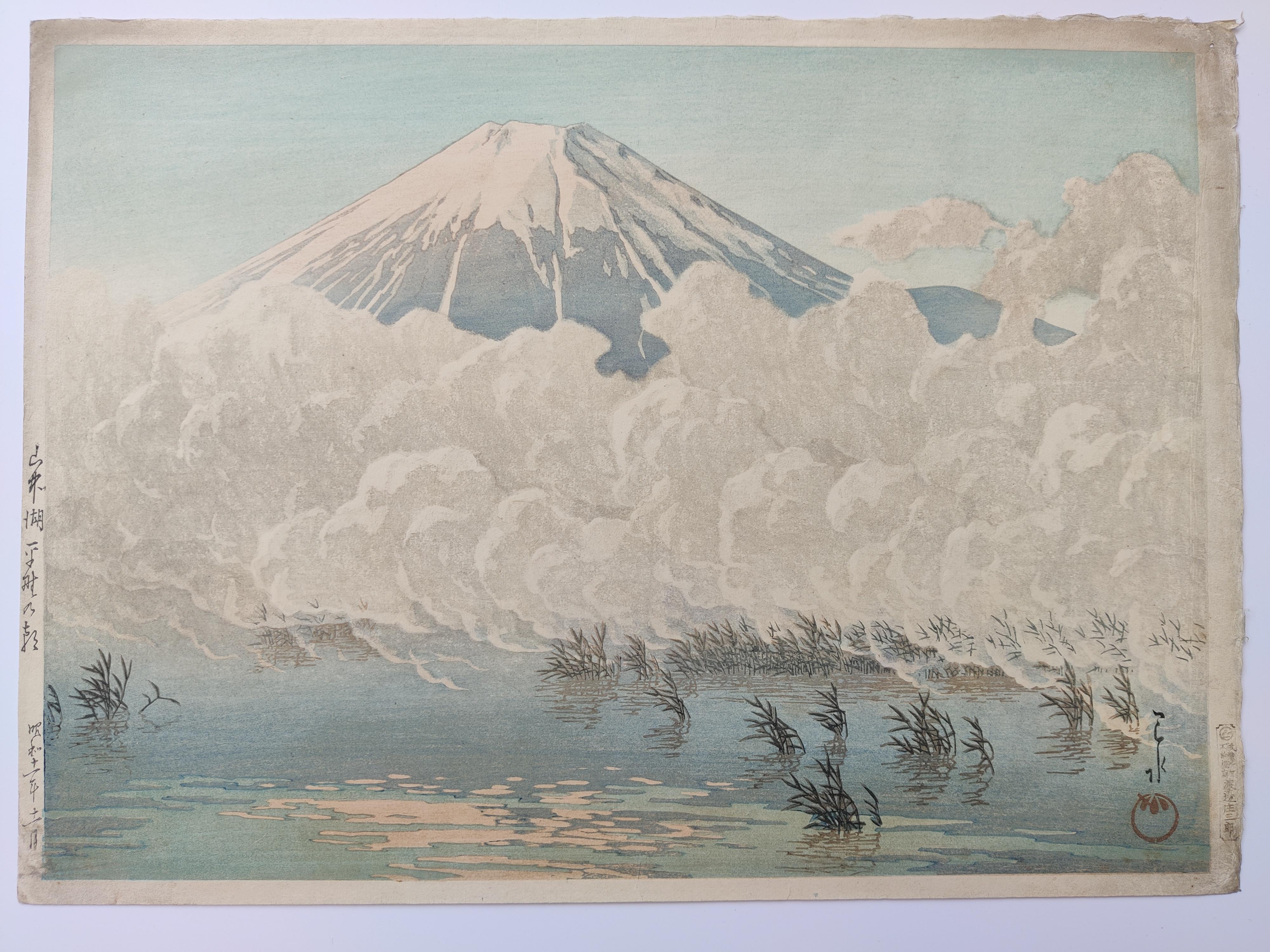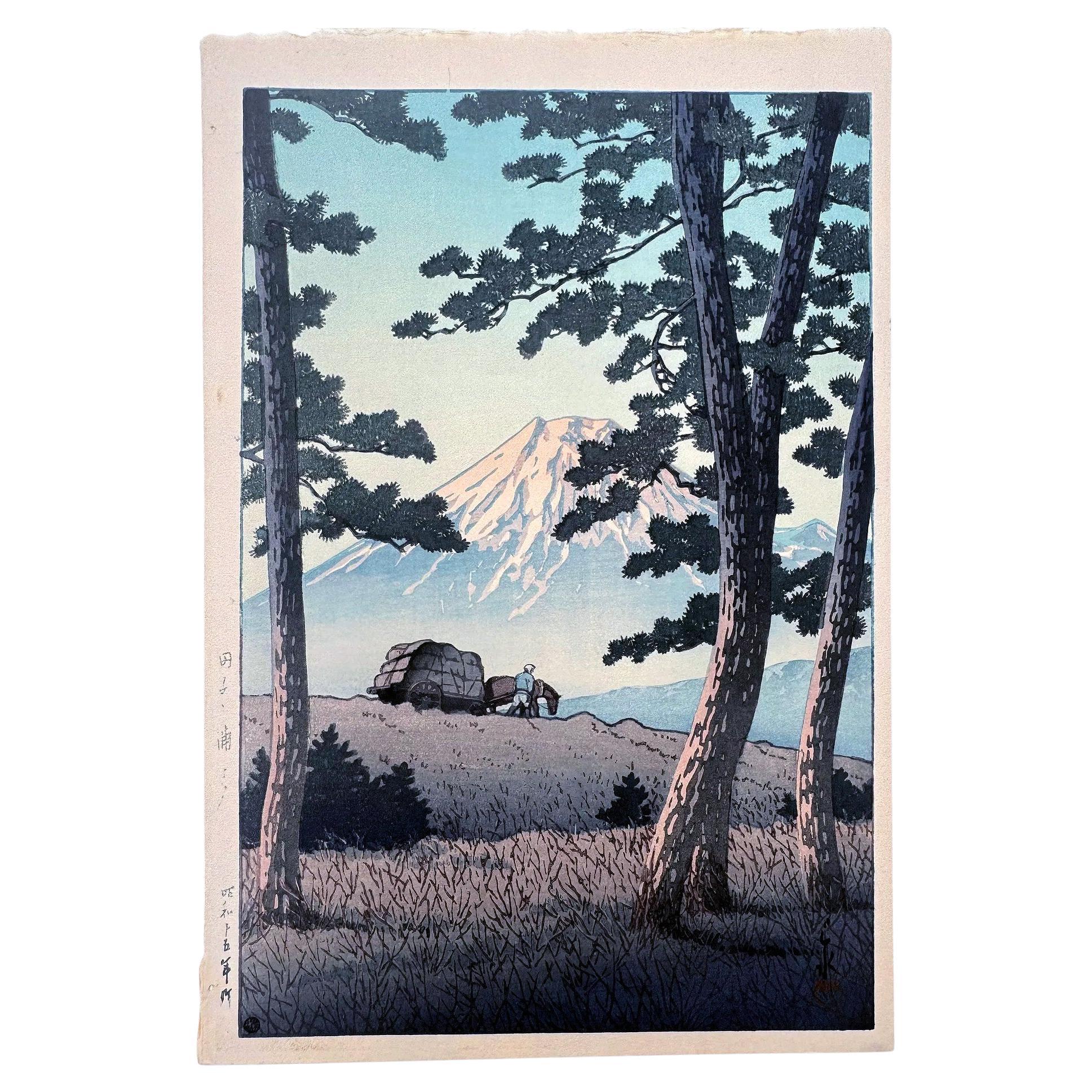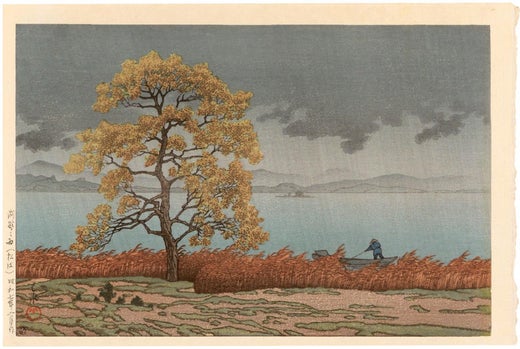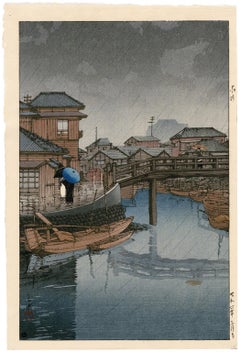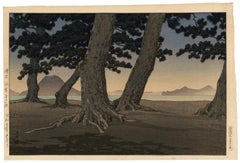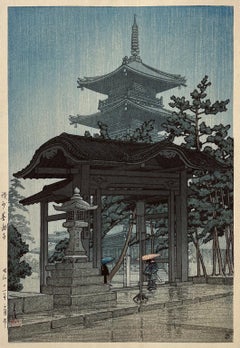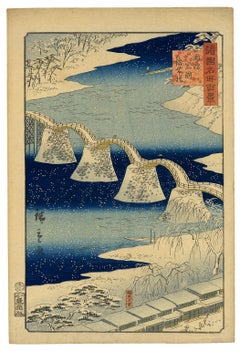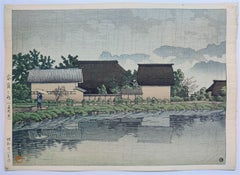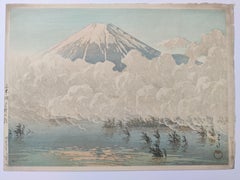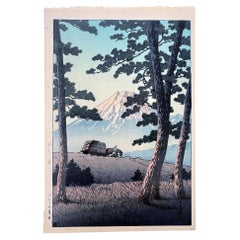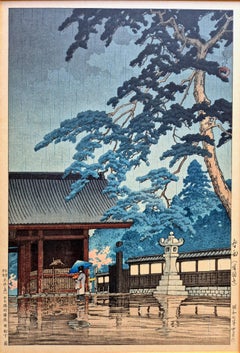Articles similaires à Douche au bord du lac, Matsue" - Impression à la planche de bois en couleurs de l'ère Showa
Vous voulez plus d'images ou de vidéos ?
Demander au vendeur plus d'images ou de vidéos
1 sur 3
Kawase HasuiDouche au bord du lac, Matsue" - Impression à la planche de bois en couleurs de l'ère Showa1932
1932
1 641,57 €
À propos de cet article
Kawase Hasui, 'Chihan no Ame, Matsue' (Lakeside Shower, Matsue), color woodblock print, 1932. A fine, atmospheric impression, with fresh colors; the full sheet, from a postwar edition, in excellent condition. Signed 'Hasui' with the artist’s red seal 'Sui', lower left. Published by Watanabe Shozaburo with the Watanabe 6mm round seal, lower left. Archivally sleeved, unmatted.
Image size 14 1/4 x 9 3/8 inches (362 x 238 mm); sheet size approximately 15 1/2 x 10 3/8 inches (391 x 264 mm).
Impressions of this work are in the permanent collections of the Art Institute of Chicago, Harvard Art Museum, Missouri University Museum of Art and Archaeology, Museum of Fine Arts Boston, and Smithsonian National Museum of Asian Art.
ABOUT THE ARTIST
“I do not paint subjective impressions. My work is based on reality...I can not falsify...(but) I can simplify…I make mental impressions of the light and color at the time of sketching. While coloring the sketch, I am already imagining the effects in a woodblock print.” — Kawase Hasui
Kawase Hasui (1883–1957) is the most celebrated 20th-century Japanese print designer of the shin-hanga ('new prints') movement pioneered by the renowned publisher Watanabe Shozaburo. Hasui worked almost exclusively on landscape and townscape prints based on his sketches in Tokyo and during his travels in Japan. His subjects are not only 'meishō' (famous places) prints, which were typical of the earlier ukiyo-e masters such as Hiroshige and Hokusai, but also feature tranquil and picturesque scenes in obscure locations. Hasui considered himself a realist and employed his training in Western painting to create his lyrical renderings with naturalistic light, shade, and texture. Hasui was able to evoke the fleeting beauty of Japan during the interwar period as no printmaker of his time could.
Hasui's work enjoyed great popularity upon producing his first print in 1918. Watanabe recognized and cultivated the enormous potential of the American market, resulting in Hasui's prints achieving high prices at auctions in New York as early as the 1920s. After the Second World War, his prints became highly sought-after collectible works among the American occupying forces in Japan. Hasui designed more than 600 prints during the 40 years of his artistic career, and in 1956, he was named a 'Living National Treasure' of Japan.
Hasui’s woodblock prints are included in many important museum collections of Japanese prints worldwide, including the Art Institute of Chicago, British Museum, Brooklyn Museum, Clark Art Institute, Cooper Hewitt, Smithsonian Design Museum, Freer Gallery of Art, Harvard Art Museums, Indianapolis Museum of Art, The Israel Museum (Jerusalem), Japan Ukiyo-e Museum (Matsumoto, Japan), Los Angeles County Museum of Art, Metropolitan Museum of Art, Minneapolis Institute of Art, MOA Museum of Art (Japan), Museum of Fine Arts Boston, Nelson-Atkins Museum of Art, Portland Art Museum, Stanley Museum of Art, Toledo Museum of Art, Tokyo Museum Collection (Japan), University of Michigan Museum of Art, Walters Art Museum, Smart Museum of Art, and the Virginia Museum of Fine Arts.
- Créateur:Kawase Hasui (1883-1957, Japonais)
- Année de création:1932
- Dimensions:Hauteur : 36,2 cm (14,25 po)Largeur : 23,83 cm (9,38 po)
- Support:
- Mouvement et style:
- Période:
- État:
- Adresse de la galerie:Myrtle Beach, SC
- Numéro de référence:Vendeur : 982031stDibs : LU532316471182
Kawase Hasui
Hasui Kawase (Japonais, 1883 -1957) était un artiste, l'un des graveurs les plus importants et les plus prolifiques du Japon moderne. Il a été l'un des principaux créateurs du mouvement shin-hanga ("nouvelles estampes"), dont les artistes ont représenté des sujets traditionnels dans un style influencé par l'art occidental. Comme beaucoup d'estampes ukiyo-e antérieures, les œuvres de Hasui étaient généralement des paysages, mais présentaient des effets atmosphériques et un éclairage naturel. Hasui a conçu environ 620 estampes au cours d'une carrière qui s'est étendue sur près de quarante ans. Vers la fin de sa vie, le gouvernement l'a reconnu comme Trésor national vivant pour sa contribution à la culture japonaise. Dès sa jeunesse, Hasui rêvait d'une carrière artistique. Son oncle maternel était Kanagaki Robun (1829-94), un auteur et journaliste japonais qui a publié le premier magazine manga. Dans sa jeunesse, Hasui a fréquenté l'école du peintre Aoyagi Bokusen. Il réalise des croquis d'après nature, copie les gravures sur bois des maîtres et étudie la peinture au pinceau avec Araki Kanyu. Ses parents lui ont fait reprendre l'entreprise familiale de vente en gros de cordes et de fils, mais la faillite de celle-ci à l'âge de 26 ans l'a libéré et lui a permis de se consacrer à l'art. Il demande à Kiyokata Kaburagi de lui enseigner, mais ce dernier l'encourage à étudier la peinture occidentale, ce qu'il fait avec Okada Saburōsuke pendant deux ans. Deux ans plus tard, il se présente à nouveau comme étudiant auprès de Kaburagi, qui l'accepte cette fois. Kiyokata lui a donné le nom de Hasui, qui peut se traduire par "eau jaillissant d'une source", et qui dérive du nom de son école primaire combiné à un idéogramme de son nom de famille. Kawase a étudié l'ukiyo-e et la peinture de style japonais au Studio de Kiyokata Kaburagi. Il se concentre principalement sur la réalisation d'aquarelles d'acteurs, de la vie quotidienne et de paysages, dont beaucoup sont publiées comme illustrations dans des livres et des magazines au cours des dernières années de la période Meiji et au début de la période Taishō. Kawase a travaillé presque exclusivement sur des gravures de paysages et de villes à partir de croquis et d'aquarelles qu'il a réalisés à Tokyo et au cours de ses voyages au Japon. Cependant, ses estampes ne sont pas simplement des meishō (lieux célèbres) typiques des premiers maîtres de l'ukiyo-e tels que Hiroshige et Katsushika Hokusai (1760-1849). Les gravures de Kawase représentent des lieux tranquilles et obscurs dans un Japon en pleine urbanisation. Les œuvres d'Hasui sont actuellement conservées dans plusieurs musées à travers le monde, notamment le British Museum, le Toledo Museum of Art, le Brooklyn Museum, l'Indianapolis Museum of Art, le Museum of Fine Arts, Boston, le Metropolitan Museum of Art, le Portland Art Museum, le Los Angeles County Museum of Art, le University of Michigan Museum of Art, le Minneapolis Institute of Art, le Stanley Museum of Art, le Walters Art Museum, le Clark Art Institute, le Smart Museum of Art, le Nelson-Atkins Museum of Art et le Virginia Museum of Fine Arts.
À propos du vendeur
5,0
Vendeur reconnu
Ces vendeurs prestigieux sont des leaders du secteur. Ils représentent le summum en matière de qualité et de design.
Vendeur Platine
Vendeurs premium dont la note est supérieure à 4,7 et le délai de réponse de 24 heures maximum
Établi en 1995
Vendeur 1stDibs depuis 2016
321 ventes sur 1stDibs
Temps de réponse habituel : 1 heure
Associations
International Fine Print Dealers Association
- ExpéditionRecherche du devis...Expédition depuis : Myrtle Beach, SC
- Politique des retours
Certaines parties de cette page ont été traduites automatiquement. 1stDibs ne garantit pas l'exactitude des traductions. L'anglais est la langue par défaut de ce site web.
Garantie d'authenticité
Bien qu'il soit peu probable que la situation se présente, dans le cas où vous rencontreriez un problème d'authenticité d'un article, contactez-nous dans un délai d'un an pour obtenir un remboursement intégral. DétailsGarantie de remboursement
Si votre article n'est pas conforme à la description, est endommagé pendant le transport ou ne vous est pas livré, contactez-nous sous 7 jours pour obtenir un remboursement intégral. DétailsAnnulation sous 24 heures
Vous disposez d'un délai de 24 heures pour annuler votre achat sans motif.Des vendeurs professionnels agréés
Nos vendeurs de renommée mondiale doivent respecter des normes strictes en matière de service et de qualité, afin de préserver l'intégrité de nos fiches produit.Garantie d'alignement des prix
Si vous constatez qu'un autre vendeur a mis en vente le même article à un prix inférieur sur un autre site, nous nous alignerons sur ce prix.Livraison en toute confiance à l'international
Notre réseau de transporteurs de premier ordre propose des options d'expédition spécialisées dans le monde entier, y compris des livraisons personnalisées.Plus d'articles de ce vendeur
Tout afficher'Rain at Shinagawa, Ryoshimachi' — Showa-era Woodblock Print
Par Kawase Hasui
Kawase Hasui, 'Rain at Shinagawa, Ryoshimachi' from the series 'Selection of Views of the Tokaido', woodblock print, 1931. A very fine, atmospheric impression, with fresh colors; the...
Catégorie
années 1930, Showa, Estampes - Figuratif
Matériaux
Gravure sur bois
« La plage de Kaiganji dans la province de Sanuki » - Impression à vie
Par Kawase Hasui
La plage de Kaiganji dans la province de Sanuki (Sanuki Kaiganji no hama), de la série Vues du Japon II, édition du Kansai (Nihon fûkei shû II Kansai hen), gravure sur bois, 1934. Un...
Catégorie
années 1930, Showa, Estampes - Paysage
Matériaux
Gravure sur bois
Le temple Zentsuji sous la pluie - extrait de la collection Collectional du Japon II
Par Kawase Hasui
Kawase Hasui, 'Zentsuji Temple in the Rain' tiré de la série 'Collected Views of Japan II', gravure sur bois en couleur, 1937. Signée Hasui à l'encre noire, avec le sceau rouge de l...
Catégorie
années 1930, Showa, Estampes - Paysage
Matériaux
Gravure sur bois
Bridge at Iwakuni dans la province de Suo (Suo iwakuni kintai-bashi), 1859
Par Hiroshige II
Utagawa Hiroshige II (1829-1869), "Pont Kintai à Iwakuni dans la province de Suo" (Suo iwakuni kintai-bashi), de la série "Cent vues de lieux célèbres dans les provinces" (Shokoku me...
Catégorie
années 1850, Edo, Estampes - Paysage
Matériaux
Gravure sur bois
Carpe et châtaigne d'eau" - Impression à vie de Showa
Par Ohara Koson
Ohara Koson (1877-1945), "Carpe et châtaigne d'eau", gravure sur bois en couleur, 1926. Une belle impression, avec des couleurs fraîches, sur du papier Japon crème ; la feuille entiè...
Catégorie
années 1920, Showa, Estampes - Animaux
Matériaux
Gravure sur bois
Tokaido, mont Fuji Rising
Par Utagawa Kunisada (Toyokuni III)
Utagawa Kunisada (Tokoyuni III), "Tokaido", gravure sur bois en couleur, 1863. Signé dans le cartouche, en bas à droite. Une belle impression, avec des couleurs riches et fraîches et...
Catégorie
années 1860, Edo, Estampes - Figuratif
Matériaux
Gravure sur bois
Suggestions
Kawase Hasui - Rain à Yasuniwa (Nagano)
Par Kawase Hasui
Kawase Hasui
Pluie à Yasuniwa (Nagano), 1946
gravure sur bois en couleurs
Signé sur le bloc, scellé, titré et daté à l'encre
Éditeur : Shozaburo Watanabe, avec son sceau de 6 mm
Le p...
Catégorie
années 1940, Estampes - Paysage
Matériaux
Gravure sur bois
2 737 € Prix de vente
20 % de remise
Kawase Hasui -- Matinée à Hirano, lac Yamanaka (山中湖平野の朝)
Par Kawase Hasui
Kawase Hasui
Matinée à Hirano, lac Yamanaka (山中湖平野の朝), 1936
Imprimé en bois coloré
Oban
Feuille : 31 × 42 cm
Image : 28,7 × 40 cm
Sceau de la première édition : Sceau "D
Publié par W...
Catégorie
années 1930, Estampes et éditions
Matériaux
Gravure sur bois
Gravure sur bois japonaise Soirée à la baie de Tago par Kawase Hasui
Par Kawase Hasui 1
Cette estampe de Kawase Hasui (1883-1957), intitulée Soirée à la baie de Tago (Tago no ura no yube), de la série Vues choisies de la route de Tokaido (Tokaido fukei senshu) a été cré...
Catégorie
Vintage, années 1940, Japonais, Moderne, Estampes
Matériaux
Papier
Kawase Hasui - Rain de printemps au temple Gokoku
Par Kawase Hasui
Kawase Hasui
Pluie de printemps au temple Gokoku-ji, 1932
Gravure sur bois
1ère publication : 1932
Taille de la feuille : 39 × 26 cm
Date de la présente édition : 1932, 1ère éditi...
Catégorie
années 1930, Estampes et éditions
Matériaux
Gravure sur bois
7 464 € Prix de vente
20 % de remise
Kawase Hasui Shinagawa d'après des vues de la série Tokaido
Par Kawase Hasui 1
Une magnifique gravure sur bois aux couleurs vives du célèbre artiste japonais et maître graveur de Shin-Hanga Kawase Hasui. Cette estampe, intitulée "Shinagawa", est tirée de sa sér...
Catégorie
Vintage, années 1930, Japonais, Showa, Estampes
Matériaux
Papier
Hasui NIGHT FISHING AT ITAKO Gravure sur bois
Artistics/Designer ; Fabricant : Hasui Kawase (japonais, 1883-1957)
Marque(s) ; notes : sceau de l'artiste ; circa 1935
MATERIAL : gravure sur bois
Dimensions (H, L, P) : 5,5 "h, 3,...
Catégorie
20ième siècle, Moderne, Estampes - Paysage
Matériaux
Gravure sur bois
